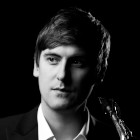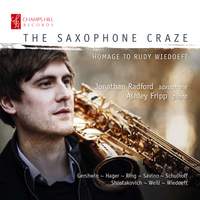Interview,
Jonathan Radford on the rise of the saxophone
 The saxophone today is so ubiquitous that it's hard to imagine a time when it was considered a novelty, toy-like instrument, a newfangled invention disregarded by serious musicians. Yet this is the background that a new album from saxophonist Jonathan Radford explores – focusing on the advocacy of "early adopter" and musical entrepreneur Rudy Wiedoeft, whose shrewd promotion of this strange new instrument changed the musical landscape forever.
The saxophone today is so ubiquitous that it's hard to imagine a time when it was considered a novelty, toy-like instrument, a newfangled invention disregarded by serious musicians. Yet this is the background that a new album from saxophonist Jonathan Radford explores – focusing on the advocacy of "early adopter" and musical entrepreneur Rudy Wiedoeft, whose shrewd promotion of this strange new instrument changed the musical landscape forever.
I spoke to Jonathan about how the "saxophone craze" came about, and Wiedoeft's pivotal role in establishing the instrument's credentials.
The very idea of simply inventing a brand-new instrument seems rather strange when one thinks about it. What drove Adolphe Sax’s decision to create a whole new instrument family?
Unfortunately Adolphe Sax left us no personal account of how or why he invented the saxophone. Some suggest that he accidentally created the saxophone whilst working on ways to improve the clarinet, others speculate that he simply added a clarinet mouthpiece onto an ophicleide (a keyed brass instrument). It’s impossible to know for sure, but above all it’s clear that Sax was a highly skilled and gifted instrument manufacturer with much foresight.
Contemporaries of Sax tell us that he wanted to create a completely new type of sound, an instrument that would combine the characteristics of different families of instruments. Sax knew that woodwind instruments tended to produce softer sounds compared with the more vigorous sound of brass instruments and that stringed instruments couldn’t match the brass in terms of volume in an orchestra.
It’s believed that the saxophone was intended to bring together power and softness, to produce a powerful, ample, expressive and fine sound that would offer a balance between the loud and weak sounds of the orchestra.
The extent to which the saxophone languished outside the mainstream of instruments before the 1920s and Wiedoeft’s promotional efforts is striking. Without him, do you think it might have faded into obscurity and been forgotten about?
I think the saxophone would almost certainly have been forgotten without Wiedoeft, or at least have had a very different development. Before Wiedoeft the saxophone was considered little more than a toy or a novelty. Wiedoeft not only inspired generations of saxophonists (and composers), but he was also largely responsible for ‘The Saxophone Craze’ - a period of time during the 1920’s in America where the saxophone became so popular that some states had to introduce saxophone curfews!
Much of the repertoire you’ve chosen here represents that brief window when the saxophone seemed to be on the cusp of entering the orchestra as well as establishing itself as central to jazz. While it undeniably achieved the latter, why do you think it never quite managed the former?
One of Wiedoeft’s principal aspirations was that the saxophone would be considered a concert instrument. Although Wiedoeft was truly versatile across a variety of genres and styles, it was his popular music that made him famous during the 1920’s. His popular ragtime influenced music resonated with the public of the Roaring Twenties, who yearned for novel entertainment following the horrors of the Great War.
Wiedoeft undoubtedly helped provide important foundations for the saxophone’s development into Jazz, but it’s been suggested that the saxophone’s success in popular styles may have actually had a negative effect on its role in the classical/orchestral world, creating a certain amount of snobbery and prejudice that essentially barred it from the ‘polite’ company of the symphony orchestra!
Today I think more people are starting to understand and appreciate the versatility of the saxophone across genres. It’s becoming more and more common to find saxophonists performing in a classical context. The versatility of the saxophone appeals to the masses – what better way to help attract new audiences to our classical concerts!
In his youth, Wiedoeft trained as a violinist. How much impact do you think this had on his development of the first saxophone technical method (and thus perhaps indirectly on saxophone performance more broadly)?
Looking at Wiedoeft’s saxophone technical method, we notice a very methodical and disciplined way of learning. It seems likely that this approach was influenced by ways of learning other instruments.
Wiedoeft grew up in a very musical family with siblings playing a whole variety of instruments, including the piano, violin, trumpet, trombone, double bass and drums. We think Wiedoeft studied the violin with his father (who had trained in a German conservatoire). Later Wiedoeft learnt the clarinet before teaching himself the saxophone, and as he had no access to saxophone methods he used oboe methods.
Ultimately, this resulted in Wiedoeft producing an extremely individual and personal way of playing the saxophone. I find this very interesting; there is always something to learn and borrow from other instruments.
Given his savvy, entrepreneurial ability to spot the saxophone’s potential before anyone else, how did Wiedoeft allow himself to be overtaken in turn by the next generation of music – with jazz eclipsing his vaudeville/ragtime style?
It’s difficult to know. It may be because he died relatively early, but there are perhaps stronger reasons on which we can speculate. It seems likely that he was either unable, or unwilling, to adapt to the changing musical genres and styles that took place following the Wall Street Crash in 1929. From the late 20’s / early 30’s we start to see a decline in his popularity in America, and during this time he moved to Europe where his vaudeville/ragtime style was still popular for a few years longer. Perhaps by the time he moved back to the US he felt that he was already too late to move into these newer styles.
Jonathan Radford (saxophone), Ashley Fripp (piano)
Available Formats: CD, MP3, FLAC, Hi-Res FLAC



